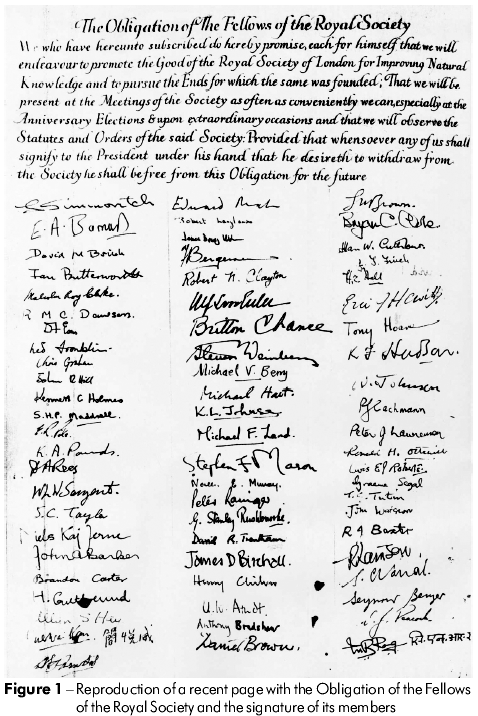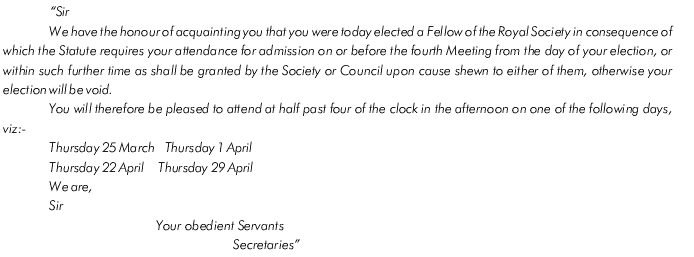Servicios Personalizados
Revista
Articulo
Indicadores
-
 Citado por SciELO
Citado por SciELO
Links relacionados
-
 Similares en
SciELO
Similares en
SciELO
Compartir
Revista Pan-Amazônica de Saúde
versión impresa ISSN 2176-6215versión On-line ISSN 2176-6223
Rev Pan-Amaz Saude v.1 n.3 Ananindeua sep. 2010
http://dx.doi.org/10.5123/S2176-62232010000300001
EDITORIAL | EDITORIAL | EDITORIAL
The 350 years of the Royal Society of London
Os 350 anos da Royal Society of London
Los 350 anos de la Royal Society of London
Ralph Lainson
Seção de Parasitologia, Instituto Evandro Chagas, Secretaria de Vigilância em Saúde, Ministério da Saúde, Ananindeua, Pará, Brasil
In the midst of the civil unrest that was disastrously interrupting the progress of learning and research in England during the middle of the 17th Century, a small but remarkable group of men withdrew from the political scene and enthusiastically devoted their attention to the process of scientific research which they then referred to as "experimental philosophy". They decided to meet weekly in London to discuss the problems facing scientific research and to conduct experiments that might test theories and hypotheses in attempts to ascertain the actual truth.
Following the return of King Charles II to London, the group resolved to form a definitive and organized Society and, to obtain sufficient funds to defray the costs of their experiments, it was stipulated that each member (at the time numbering 115) should contribute the modest sum of one shilling per week! A "Journal Book" was commenced on December 5th, 1660 and has continued in the same format till this day. Each page was headed with the aims of the Society (Figure 1). These are then followed by the signatures of those prepared to join and support such a Society.

In the first three pages of the year 1660, there were a number of notable names among the signatures, including that of Lord Brouncker, an eminent mathematician and first President of the Royal Society; Sir Robert Moray, a prominent naturalist; the Honourable Robert Boyle, a leading pioneer in physics and chemistry; Sir William Petty, expert in mathematics, anatomy, mechanics and geodesy; Isaac Barrow, the trusted tutor of Isaac Newton; Christopher Wren, remembered as the greatest of all English architects and the man who constructed Saint Paul's Cathedral in London; and John Wilkins, later to become Bishop of Chester, an expert in mathematics and mechanics and who forecasted submarine navigation and aviation. As to be expected, medicine had a number of representatives and provided several future Presidents of the Royal College of Physicians.
In 1671 Isaac Newton, famed for his law of gravity, was elected Fellow of the Royal Society (FRS) and, in 1703, was appointed President - a post he was to hold until his death in 1727.
The Royal Society, or the "Royal Society of London for improving Natural Knowledge", as it was also known, dates its corporate existence from July 15th, 1662, when the first Charter was signed by King Charles II. From its earliest years it published separate treatises or books on matters of philosophy, the most distinguished of these being the "Philosophise Naturalis Principia Mathematica. Autore Isaac Newton. ImprimaturS, Pepys. Reg. Soc. Prseses. Julii 5, 1686, Londini 1687".
In 1887 the Philosophical Transactions were divided into the two Series: A (for papers of mathematical or physical nature) and B (for those of biological character); later this gave rise to the current Proceedings of the Royal Society, Series A and B.
The various British governments have constantly appealed to the Royal Society for advice in connection with their major scientific undertakings. Thus, the organization and funding of the Antarctic Expeditions of Cook, in 1772, which extended to the circum-navigation of the world, and observations for determining the planet's density; deep-sea research in 1872; the "Challenger Expedition" of 1879; research on colour-blindness in1895, among many other investigations. In later years the Royal Society has taken a leading part in research on various tropical diseases, particularly on trypanosomiasis of cattle and man in Africa and the great problems of malaria and leishmaniasis (an expedition was made to specifically study visceral leishmaniasis in China). Another important duty has been the administration of an annual grant for the promotion of scientific research, and assistance to enable publication of the findings. Special lectures were delivered through the Royal Society; the Croonian, Bakerian and Ferrier addresses on advances in our knowledge regarding the structure and function of the brain; the Wilkins lecture on the history of science; and the Leeuwenhoek lecture on a variety of microbiological subjects.
Under the statutes of the Royal Society, all candidates for election into the Society must be recommended by a certificate signed by six or more fellows, of whom at least three must indicate a personal knowledge of the candidate's contribution to science. From the candidates the Council then selects a relatively small number of names which are submitted to the Society for election by ballot. Foreign members may be selected by the Council from among individuals of the greatest scientific eminence abroad, and proposed to the Society for election.
The Royal Society traditionally maintains a delightfully quaint wording when notifying successful candidates of their election, as follows:

The newly elected Fellow must sign the Charter-Book with a replica of the ancient goose-quill pen, as used throughout the Royal Society's history, and he or she is made to practice writing his or her signature without making the blobs of spilt ink that appear on many of the early pages of signatures!
To use the words of Archibald Geikie, President of the Society in 1912:
"The long array of signatures... is a touching memorial of the men whom the marvellous progress of modern science has been mainly due in the onward march of discovery, each receiving the torch of knowledge from those who went before and passing it on, with brighter glow, to those who came next. It is the link which these men had with the Royal Society that unites them all... in one great company. In looking back upon its past history, the Royal Society may point with pride to the long roll of illustrious men who have honoured it by accepting its Fellowship".











 texto en
texto en 

